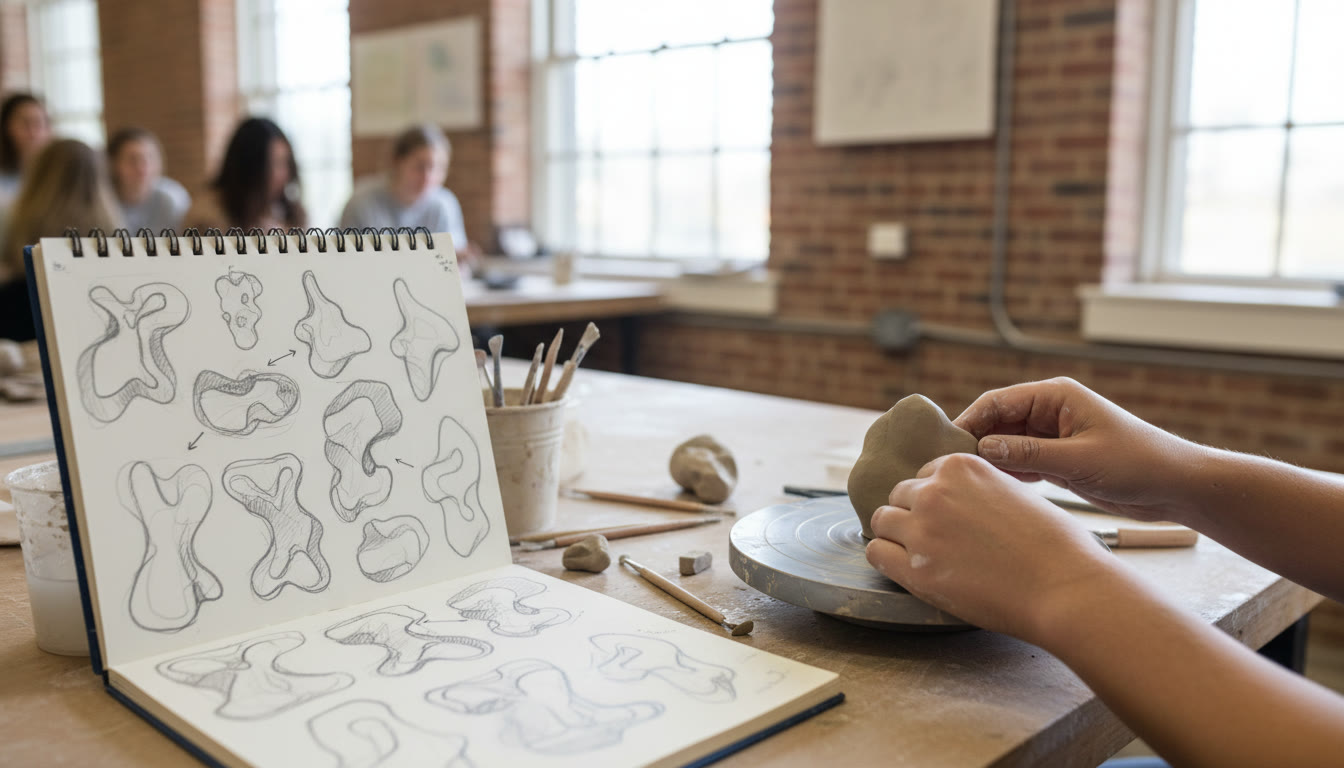Choosing 2-D vs Drawing vs 3-D: Which AP Studio Art Path Suits You?
Deciding which AP Studio Art portfolio to pursue is one of those moments that feels both exciting and a little terrifying. You’ve probably seen stunning portfolios online, heard upperclassmen rave about one class or another, or wondered which path will impress colleges — and, more importantly, which will help you grow as an artist. This guide is here to walk you through AP 2-D Design, AP Drawing, and AP 3-D Design in a human, practical way: what each course emphasizes, how portfolios are judged, who each course suits best, and how to make a confident choice that matches your strengths and goals.
Quick Overview: What Each AP Studio Art Portfolio Means
Before we dive into the details, here’s a snapshot so you know what we’re comparing.
- AP 2-D Design: Focus on two-dimensional principles — composition, color, surface, design problem solving, and visual organization. It’s about images and planar thinking, not just drawing skills.
- AP Drawing: Emphasis on mark-making, observational drawing, figure, still-life, and expressive use of line, value, and composition. It’s the classic drawing route.
- AP 3-D Design: Oriented to three-dimensional thinking — sculpture, ceramics, installation, functional objects, or any work that occupies physical space. Consider form, structure, and materiality.
How AP Studio Art Portfolios Are Assessed
All three portfolios share the same broad structure: students submit a collection of artworks and process evidence that demonstrates growth, breadth, and sustained investigation. The exam isn’t a timed test in a classroom — it’s a curated portfolio, judged by readers who look for visual mastery, conceptual thinking, and a clear voice. Successful portfolios show intentional choices and a coherent investigation across multiple works.
Which Course Is Right For You? Questions To Ask Yourself
Choosing isn’t just about liking something — it’s about aligning the course with how you think, create, and want to develop. Ask yourself:
- Do I prefer working on flat surfaces (paper, digital canvases) or creating objects that can be walked around?
- Am I energized by solving visual design problems, or by capturing form, light, and line through observation?
- Do I enjoy repeated iterations and experimenting with materials and structure?
- What kind of portfolio would best showcase my strongest work for college applications?
Match Profiles: Quick Personality + Skill Fit
- AP 2-D Design: Great for students who think in layout, pattern, typography, digital composition, photography, printmaking, or textile surface design. If you love composition and design decisions — this could be your lane.
- AP Drawing: Ideal for those who love direct observation, expressive mark-making, charcoal and ink, and developing sensitivity to tone, proportion, and gesture.
- AP 3-D Design: Best for makers who enjoy building, problem-solving with materials, engineering forms, and thinking about how objects occupy space.
Digging Deeper: What You’ll Learn and Practice
AP 2-D Design — Key Skills and Project Types
2-D design classes teach you to think about visual organization and communication. Expect to:
- Explore composition, balance, repetition, rhythm, contrast, and scale.
- Work across media: photography, collage, printmaking, digital design, painting, and mixed-media pieces that emphasize surface and image relationships.
- Tackle design problems — e.g., create series exploring negative space, or develop a set of images that visually interpret a concept.
AP Drawing — Key Skills and Project Types
Drawing is about seeing deeply and rendering that vision. You’ll:
- Refine techniques with graphite, charcoal, ink, pastel, and other mark-making tools.
- Focus on observational skills: still lifes, portraits, figure studies, landscapes that rely on value, line, and perspective.
- Develop expressive and conceptual work where drawing becomes the primary means of communication.
AP 3-D Design — Key Skills and Project Types
3-D design pushes you into the physical world of form and structure. You’ll:
- Learn about sculptural processes, joining methods, mold-making, clay, papier-mâché, wood, metal, and/or found materials.
- Think about ergonomics, balance, and spatial relationships.
- Create functional and nonfunctional work — from small objects to installations.
Portfolio Anatomy: What to Show and How to Organize It
Across the three paths, the portfolio typically contains submissions that evidence: quality (your best work), concentration (a sustained investigation of a theme), and breadth (varied approaches and media). Here’s a practical layout you can use when planning.
| Portfolio Section | What It Shows | Examples by Course |
|---|---|---|
| Quality | Top 5–8 strongest pieces demonstrating technical command | 2-D: Final image series; Drawing: Large charcoal portrait; 3-D: Refined ceramic vessel |
| Concentration | Series of works exploring a single idea or problem | 2-D: Variations on negative space; Drawing: Repeated figure studies; 3-D: Iterations of joinery and balance |
| Breadth | Evidence of experimenting with varied techniques and media | 2-D: Photo experiments, screen prints; Drawing: Ink, pencil, pastel; 3-D: Clay, mixed materials |
Practical Tips for Every Portfolio
- Start early: meaningful concentration requires time. Don’t cram a series into a single week.
- Document the process: photos of works-in-progress, sketches, and idea maps help show your development.
- Prioritize quality over quantity: a focused set of excellent pieces beats many mediocre ones.
- Get feedback from multiple readers — teachers, peers, and if possible, personalized tutoring to tighten ideas and presentation.

How Colleges View Each Portfolio
Colleges generally appreciate portfolios that show creative thinking, consistency, and technical skill — regardless of which AP Studio Art path you chose. However, your choice can matter for certain art or design programs:
- If you’re applying to an art school, a 3-D portfolio demonstrates tactile and spatial skills; a drawing portfolio shows strong observational and figure work; a 2-D portfolio indicates strong visual communication and design thinking.
- Liberal arts or non-art-specific programs mainly look for evidence of curiosity and discipline — strong visual thinking is valuable everywhere.
Match Portfolio to Application Goals
If you’re aiming for a competitive art program, think about what your intended major emphasizes and tailor your body of work. If you’re uncertain, 2-D can be flexible for graphic design or illustration, Drawing is a classic foundation, and 3-D speaks to sculpture, industrial design, and architecture-related fields.
Common Student Scenarios — Which Course Fits Best?
Let’s walk through common student profiles and the recommendations that fit them.
Scenario 1: The Digital Native Who Loves Composition
You’re into photography, digital collage, and poster design. You think in layers and patterns and enjoy software like Photoshop or Procreate. AP 2-D Design will let you translate those strengths into a portfolio that focuses on visual organization and surface.
Scenario 2: The Obsessed Observer
You love figure drawing, charcoal, and capturing light. You’re energized by long observation sessions and nuanced shading. AP Drawing is the natural path — it builds on what you already love and asks you to deepen your observational and expressive skills.
Scenario 3: The Maker and Tinkerer
If you’re happiest with materials in your hands — building, sculpting, or designing objects — AP 3-D Design lets you show how your ideas occupy space. It rewards problem solvers who enjoy iteration and learning material properties.
Classroom vs Independent Study: How to Prepare
Whether you take the AP class at school or build an independent portfolio, the work principles remain the same: consistent output, deliberate experimentation, and thoughtful reflection. Many students blend structured class time with independent projects or summer work so their AP portfolio has depth and time-based evolution.
How Personalized Tutoring Helps (Yes — Sparkl’s Mentioned Naturally)
Targeted, 1-on-1 guidance can accelerate your portfolio’s maturity. Personalized tutors help you clarify a concentration, tighten composition decisions, and choose the strongest images. If you’re juggling AP classes, extracurriculars, and college apps, a tutor from a service (for example, Sparkl’s personalized tutoring) who offers tailored study plans, expert feedback, and AI-driven insights can provide the structure and critique loop you need to elevate work from good to compelling.
Examples And Project Ideas To Jumpstart Your Portfolio
Concrete prompts can spark direction. Below are starter ideas keyed to each path — treat them as seeds, not templates.
2-D Design Project Ideas
- Series: “Urban Textures” — photographs and mixed-media explorations of repeating patterns and negative space found in city infrastructure.
- Typographic Posters — create a set of posters that use type as image to communicate emotion without figurative imagery.
- Photo-Collage Narrative — combine found photos, prints, and hand-drawn elements to tell a short visual story.
Drawing Project Ideas
- Sustained Figure Investigation — 10 studies of the same model in varied light and poses, moving from quick gestures to refined portraits.
- Material Study Series — render the same object (e.g., glass bottle) in charcoal, ink wash, and graphite to explore mark-making and value.
- Concept Drawing — pair short written reflections with drawings that visually interpret a memory or personal myth.
3-D Design Project Ideas
- Functional Object Exploration — iterate on a chair or lamp design focusing on ergonomics and material joins.
- Site-Specific Installation — create a small-scale installation that responds to a chosen space (school courtyard, elevator lobby).
- Modular Sculpture Series — explore how repeating elements assemble and change meaning with scale.

Time Management and Planning Your AP Portfolio
Strong portfolios are the product of steady scheduling and realistic milestones. Here’s a simple timeline for a school-year project:
- September–October: Exploratory phase. Produce many quick studies, try different media, and pick a concentration topic.
- November–January: Develop concentration. Start a coherent series and iterate on ideas; take photos and document process.
- February–March: Refine quality pieces. Choose the strongest works for final submission and prepare high-resolution documentation.
- April–May: Final polish. Edit the portfolio, write brief process statements, and prepare your submission materials.
Use Tools to Stay Organized
Track works in a visual folder, maintain a digital sketchbook, and schedule weekly critique sessions. If you feel stuck, targeted mentorship or tutoring — such as Sparkl’s tailored study plans and expert tutor feedback — can keep you accountable and provide meaningful, actionable critique.
Common Pitfalls and How to Avoid Them
- Producing too many unrelated pieces. Focus on building a coherent investigation.
- Failing to document process. Early sketches, mock-ups, and photos of staged pieces show growth.
- Ignoring scale and presentation. A powerful piece poorly photographed can lose impact; learn simple lighting and documentation techniques.
- Neglecting feedback loops. Regular critiques from teachers, peers, or a tutor sharpen your decisions.
Final Thoughts: Make the Choice Yours
Choosing between AP 2-D Design, AP Drawing, and AP 3-D Design isn’t about picking the “most impressive” option — it’s about selecting the path that stretches you and lets your unique voice emerge. Think about how you enjoy working, what makes you lose track of time, and which course will push you to build a meaningful, focused body of work. Remember: colleges admire commitment, clarity, and creativity. Whichever path you choose, the goal is to create work that feels inevitable — work that only you could have made.
Last Practical Encouragement
Start experimenting now: do short projects in each area if you can. Over a weekend, try a 2-D layout, a charcoal study, and a small assembled object. One might click instantly. And if you need help shaping ideas into a coherent portfolio or want personalized feedback on your concentration, consider a structured program with 1-on-1 guidance — tutors can offer tailored study plans and critique that turns promising work into an AP-caliber submission.
Good art-making is equal parts curiosity, discipline, and joy. Pick the path that invites you to make more — and then make boldly.














No Comments
Leave a comment Cancel